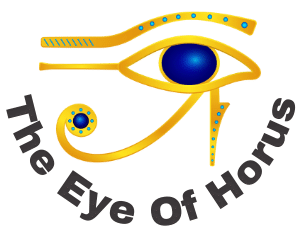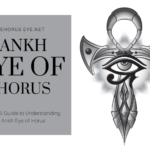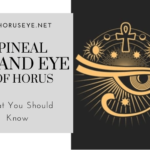Eye of Horus vs Eye of Ra, The eye of Ra represents the sun. It is always depicted as the right eye. The eye of Horus represents the moon and is always depicted as the left eye,
The Eye of Horus and the Eye of Ra are ancient Egyptian symbols that are commonly confused with each other. While both symbols are associated with the Egyptian god Horus, they have different origins and meanings.
The Eye of Horus, also known as the Wadjet, is a symbol of protection and royal power from deities, in Egyptian mythology. It was often used as a funerary amulet and was also sometimes referred to as the “all-seeing eye.” The Eye of Horus was depicted as a human eye with markings that were symbolic of the moon and the sun, with the left eye symbolizing the moon and the right eye symbolizing the sun.
On the other hand, the Eye of Ra represents the sun god Ra and his power. Ra was said to have the power to bring life and light to the world and was seen as the creator of everything. The Eye of Ra was depicted as a lioness or a cobra and symbolized the goddesses Bastet and Wadjet. In many representations, the Eye of Ra was shown as a solar disk with rays extending from it, representing Ra’s power to illuminate the world.
Both the Eye of Horus and the Eye of Ra have unique meanings and origins in ancient Egyptian mythology and are distinct symbols with different representations and connotations.
Understanding the Meaning of Ancient Symbols
The Eye of Horus is an ancient Egyptian symbol that was commonly used in various contexts, such as religion, magic, and medicine. It is believed to have originated from the story of the god Horus, who was the son of Osiris and Isis and was one of the most important gods in ancient Egyptian mythology.
In the story, Horus loses his eye in a battle with his uncle Seth, but the eye is restored by the god Thoth. The restored eye became a symbol of life and protection and was often used as an amulet to ward off evil and provide healing.
The different parts of the Eye of Horus symbol were said to represent different aspects of the god Horus. For example, the eyebrow represented the god’s power, the iris symbolized his eye, and the tear represented his tears of grief. The six parts of the Eye of Horus symbol were also associated with the senses, the brain, and various body parts.
The Eye of Horus was also used in a mathematical context and was used to represent fractions. The different parts of the Eye of Horus symbol were used to denote specific fractions, such as 1/2, 1/4, and 1/8.
The Eye of Horus is a rich and complex symbol that represents the god Horus and his mythology, and its meanings extended beyond the religious realm into other aspects of ancient Egyptian society, including mathematics and medicine.
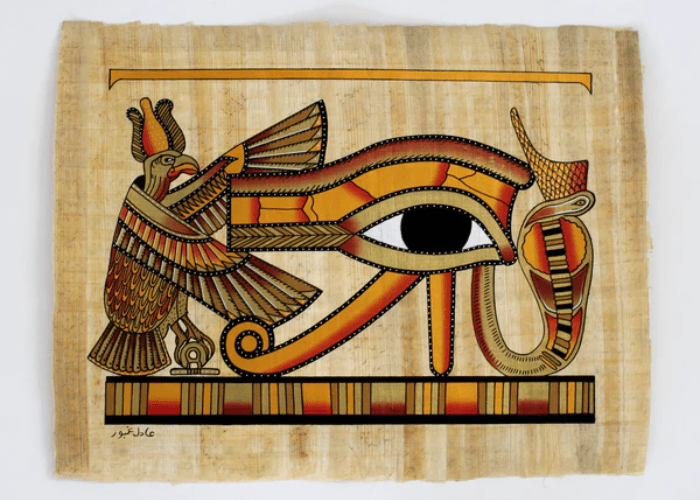
Ancient symbols are a form of visual communication that were used by different cultures throughout history to convey ideas, beliefs, and values. These symbols often had multiple layers of meaning, which were often rooted in cultural, religious, or spiritual beliefs.
For example, in ancient Egypt, the Ankh symbol represented life and was often depicted in the hands of the gods and pharaohs. In ancient Greece, the symbol of the owl was associated with wisdom and knowledge, while in Hinduism, the Om symbol represents the universe and is considered a sacred sound.
Ancient symbols are rich in meaning and are an important part of cultural heritage. They serve as a way to understand the beliefs and values of past cultures and offer insight into the cultural, religious, and spiritual beliefs that shaped the world.
How to Interpret the Eye of Horus
The Eye of Horus is an ancient Egyptian symbol that has multiple interpretations, both in a religious and cultural context. Some of the key interpretations of the Eye of Horus are:
- Protection and Healing: The Eye of Horus is often seen as a symbol of protection and healing. The story of Horus losing and then regaining his eye is interpreted as a metaphor for the cycle of life and death and the importance of restoration and renewal.
- Royal Power: The Eye of Horus was also associated with the power and authority of the pharaohs and was used to symbolize their rule over the land.
- Divine Power: As the symbol of the god Horus, the Eye of Horus represented the power of the gods and their ability to bring order to the world and protect their followers.
- Fractions: The Eye of Horus was also used as a unit of measurement and was divided into six parts, each of which was associated with a specific fraction.
- Balance and Harmony: The Eye of Horus symbolizes balance and harmony and is seen as a representation of the ideal balance between different aspects of life, such as the physical and the spiritual, the masculine and the feminine, and the material and the divine.
The Eye of Horus is a complex symbol with multiple interpretations that reflect the beliefs and values of ancient Egyptian culture. The symbol continues to hold great significance and is still used today as a symbol of protection, power, and balance.
The Following Terms Are Used for The Eye of Horus:
Here are some of the terms used to describe the Eye of Horus:
- Wadjet: This is the ancient Egyptian word for the Eye of Horus, which means “whole” or “healthy.”
- Udjat: This is another term used to describe the Eye of Horus, which means “sound eye” or “healthy eye.”
- The All-Seeing Eye: The Eye of Horus is sometimes referred to as the “all-seeing eye,” reflecting its association with protection and the ability to see all things.
- The Eye of Ra: Although the Eye of Horus and the Eye of Ra are sometimes used interchangeably, the Eye of Ra is a distinct symbol that represents the sun god Ra and his power.
- Funerary amulet: The Eye of Horus was often used as a funerary amulet in ancient Egypt and was believed to protect the deceased and ensure their safe passage into the afterlife.
- Symbol of life: The Eye of Horus is considered a symbol of life and is often associated with the concept of renewal and rebirth.
- Protector of the Pharaohs: The Eye of Horus was associated with the power and authority of the pharaohs and was used to symbolize their rule over the land.
- Mathematical symbol: The Eye of Horus was also used as a unit of measurement and was divided into six parts, each of which was associated with a specific fraction.
God Ra’s Biblical Reference
Ra, the ancient Egyptian sun god, is not directly mentioned in the Bible. However, some similarities have been drawn between Ra and the biblical God, particularly in terms of their association with the sun and their role as a creator and providers.
In the Bible, God is often referred to as the creator of the world and the source of light, which are attributes also associated with Ra. For example, in Genesis 1:3, it states, “And God said, ‘Let there be light,’ and there was light.” This can be seen as similar to Ra’s role as the source of light and life in ancient Egyptian religion.
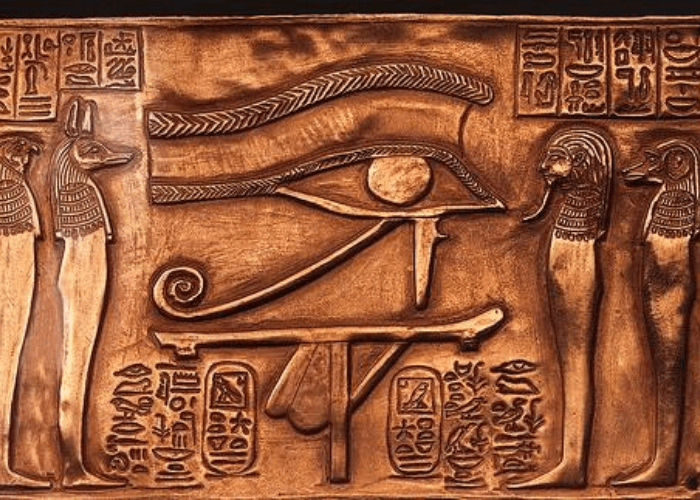
In addition, both Ra and the biblical God are associated with wisdom, power, and protection. In ancient Egyptian religion, Ra was considered a wise and powerful deity who protected his followers and maintained order in the world, which are similar to the qualities attributed to the biblical God.
It is important to note, however, that Ra and the biblical God are distinct deities with their own unique beliefs, practices, and cultural significance. While there are some similarities, the two should not be equated or conflated.
Origins, Originality, and Mythology of the Eye of Horus:
The Eye of Horus is an ancient Egyptian symbol with a rich history and mythology. The origins of the symbol can be traced back to the myth of the god Horus, who was the son of Osiris and Isis and was known as the god of the sky and war.
According to Egyptian mythology, Horus was involved in a conflict with his uncle, Set, who had killed Horus’s father, Osiris. In the course of this conflict, Horus lost one of his eyes. However, the eye was restored to him by the goddess Hathor, and it became known as the “Eye of Horus.”
The Eye of Horus was not only a symbol of healing and restoration, but it also became associated with the concepts of protection, power, and wisdom. The symbol was often used as a talisman to protect against evil and to bring good fortune.
In addition, the Eye of Horus was also used as a unit of measurement in ancient Egypt, and the six parts of the eye were each associated with a specific fraction. This made the Eye of Horus an important symbol in the fields of mathematics and science, as well as in religion and mythology.
In conclusion, the Eye of Horus is an original and powerful symbol with roots in ancient Egyptian mythology. Its association with healing, protection, power, wisdom, and mathematics has made it an enduring symbol that continues to be used and revered to this day.
Seth Came up With a Plan to Kill His Brother Osiris.
One late night, Seth crept into Osiris’s chamber and killed him. Seth succeeded Osiris as ruler of Ancient Egypt after his death. Isis was devastated. She came up with a strategy utilizing her magic to bring Osiris back to life because she was a Goddess herself. She used her powers to succeed in doing so. She brought Osiris back, but he remained in the transitional state and eventually rose to rule the underworld.
Isis became pregnant through Horus and Osiris. Horus was indeed the child of Osiris and Isis. Horus was entirely reared by Isis, and as he matured into a gentleman, he came up with a plot of his own to slay Seth and reclaim what is properly his: the throne of ancient Egypt.
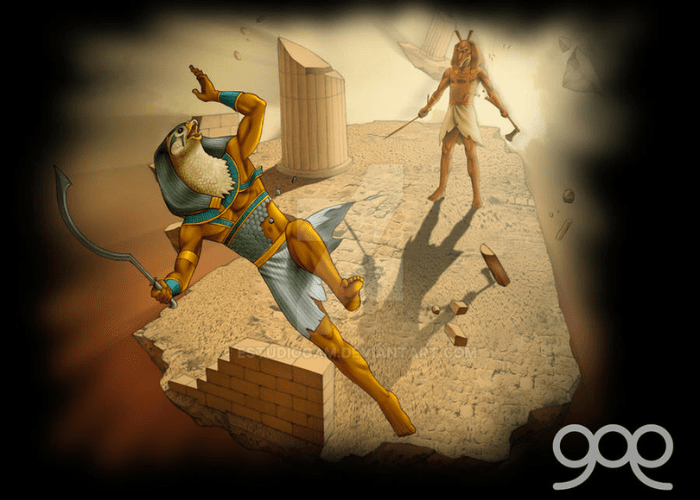
Warfare between Seth and Horus began as a result. Seth had wronged his father, and Horus was resolved to avenge him by regaining the throne of ancient Egypt. In one of these conflicts, Horus overcame Seth and took control of Egypt.
The following day, Seth entered Horus’s chamber secretly, just as he had done with his father Osiris, and severed Horus’ left eye. Then, the left eye of Horus was cured by none other than the god Thoth and Horus’s wife, Goddess Hother.
The Eye Goddess: According to Myths From the Past
The Eye of Horus was often associated with the goddess Hathor, who was considered the goddess of love, joy, and motherhood in ancient Egyptian mythology. Hathor was also known as the “Lady of the Sycamore” and was sometimes depicted as a cow-headed goddess or a woman with cow horns and a sun disk on her head.
In the myth of the Eye of Horus, Hathor played a key role in restoring the eye of the god Horus after it was damaged in his conflict with his uncle, Seth. According to the myth, Hathor transformed herself into a kite bird and flew over the battlefield, collecting the pieces of Horus’s eye and restoring them to their original form.
As a result of this act, Hathor became associated with the Eye of Horus and was revered as a protector and healer. The Eye of Horus was often used as a symbol of protection and healing and was believed to have powerful magic that could ward off evil and bring good fortune.
In conclusion, Hathor’s association with the Eye of Horus highlights the important role of the goddess in ancient Egyptian mythology and her connection to the themes of love, motherhood, and protection.
Is the Brain Related to the Horus Eye?
There is no direct connection between the Eye of Horus and the brain in ancient Egyptian mythology. The Eye of Horus was associated with the god Horus and symbolized concepts such as protection, power, and healing. The six parts of the Eye of Horus were also associated with specific fractions, making it an important symbol in mathematics and science.
In contrast, the brain was not considered a significant symbol in ancient Egyptian religion or mythology. The ancient Egyptians believed that the heart, rather than the brain, was the source of a person’s thoughts and emotions, and it was often depicted as the center of a person’s consciousness and spirituality.
However, it’s worth noting that the ancient Egyptians had a sophisticated knowledge of anatomy and were skilled in the practice of mummification, during which they removed and preserved the brain. Despite this, the brain was not given the same level of symbolic importance as other organs, such as the heart and the liver.
Powers and Spirituality of Eye of Horus vs Eye of Ra:
The Eye of Horus and the Eye of Ra are ancient Egyptian symbols with distinct meanings and spiritual associations.
The Eye of Horus was associated with the god Horus and symbolized protection, power, and healing. The six parts of the Eye of Horus were also associated with specific fractions, making it an important symbol in mathematics and science. It was often used as a talisman to protect against evil and to bring good fortune. The Eye of Horus was also seen as a symbol of the regenerative power of the sun and was associated with the concepts of rebirth and renewal.
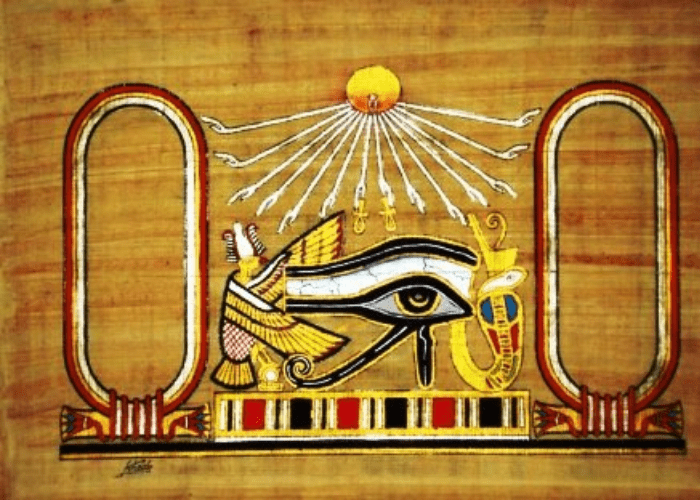
In contrast, the Eye of Ra was associated with the sun god Ra and symbolized his power and authority. Ra was considered the king of the gods and the ruler of the universe, and the Eye of Ra was seen as his instrument of power and control. The Eye of Ra was often depicted as a fierce and wrathful symbol, capable of destroying those who opposed Ra’s rule.
However, it’s worth noting that the Eye of Ra and the Eye of Horus were sometimes seen as interchangeable and were used to represent similar concepts. In some cases, the Eye of Ra was also associated with protection and healing, and the Eye of Horus was seen as a symbol of power and authority.
In conclusion, both the Eye of Horus and the Eye of Ra were powerful symbols in ancient Egyptian religion and mythology, each with its own unique spiritual associations and powers.
The Eye of Ra’s Meaning Is
The Eye of Ra was a powerful symbol in ancient Egyptian religion and mythology. It was associated with the sun god Ra and symbolized his power and authority.
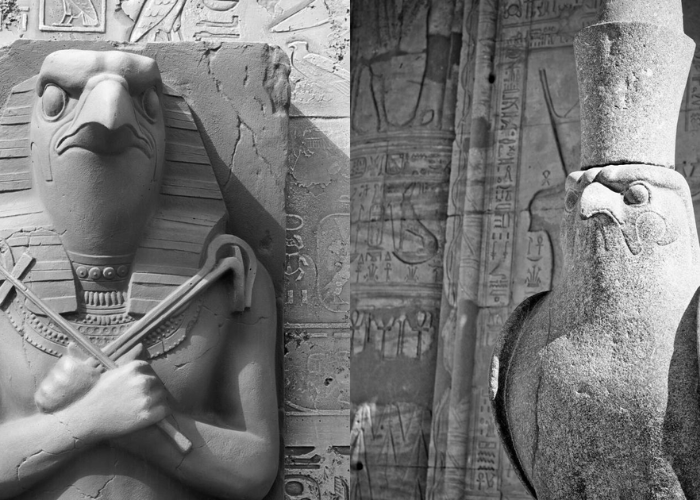
The Eye of Ra was seen as a fierce and wrathful symbol, capable of destroying those who opposed Ra’s rule. It was often depicted as a symbol of the sun’s destructive power and was associated with concepts such as fire, heat, and light.
However, the Eye of Ra was also associated with protection and healing. It was believed to have the power to ward off evil and bring good fortune and was often depicted as a symbol of Ra’s watchful eye over the world.
In addition, the Eye of Ra was a symbol of Ra’s role as the king of the gods and the ruler of the universe. The Eye of Ra represented Ra’s power and control and was seen as a reminder of his divine authority and sovereignty.
Overall, the Eye of Ra was a complex and multifaceted symbol in ancient Egyptian religion, embodying both the power and the protection of the sun god Ra.
Other Terms That Are Equivalent to “Eye of Ra” Include
The Eye of Ra is also known by several other names in ancient Egyptian religion and mythology. Some of the most common alternative names for the Eye of Ra include:
- The Udjat Eye – The Udjat Eye was one of the most common names for the Eye of Ra, and it was often used as a symbol of protection and healing.
- The Solar Eye – The Solar Eye was another name for the Eye of Ra, and it was associated with the sun and its power.
- The Sekhem Eye – The Sekhem Eye was a powerful symbol in ancient Egyptian religion, and it was associated with the god Horus.
- The Wadjet Eye – The Wadjet Eye was a powerful symbol in ancient Egyptian religion, and it was associated with the goddess Wadjet.
- The Eye of the Sun – The Eye of the Sun was a term used to describe the Eye of Ra, and it was associated with the sun god Ra’s power and authority.
Overall, the Eye of Ra was a powerful and multifaceted symbol in ancient Egyptian religion and mythology, and it was known by many different names and interpretations.
The Eye of Ra’s Originality, Origin, and Mythology:
The Eye of Ra is an ancient Egyptian symbol that has its roots in the religion and mythology of ancient Egypt. The exact origin of the Eye of Ra is not known, but it is thought to have developed over time as a symbol of the sun god Ra’s power and authority.
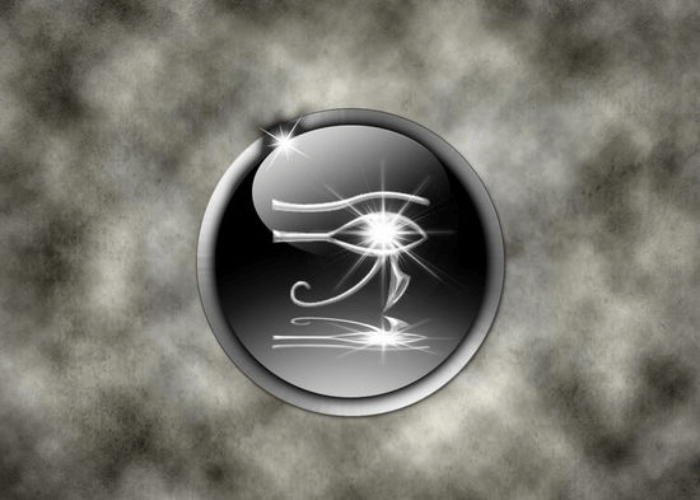
In Egyptian mythology, Ra was the king of the gods and the ruler of the universe. He was associated with the sun and was considered the source of life and light. As the sun rose each day, Ra was seen as renewing the world and providing life and sustenance to all living things.
The Eye of Ra was believed to be the physical manifestation of Ra’s power and control over the world. It was depicted as a powerful and all-seeing symbol, capable of destroying those who opposed Ra’s rule. The Eye of Ra was often associated with the sun’s destructive power and was seen as a symbol of fire, heat, and light.
However, the Eye of Ra was also associated with protection and healing. It was believed to have the power to ward off evil and bring good fortune and was often depicted as a symbol of Ra’s watchful eye over the world.
In conclusion, the Eye of Ra is an ancient symbol with roots in the religion and mythology of ancient Egypt. It was a powerful symbol of the sun god Ra’s power and authority and was associated with both protection and destruction, life and death, and the cyclical nature of existence.
How Is the Eye of Horus Used Today?
The Eye of Horus is still widely recognized and used today, both in modern Egypt and around the world. Here are a few ways in which the Eye of Horus is used:
- Jewelry – The Eye of Horus is a popular symbol in jewelry design, and can be found in the form of pendants, earrings, necklaces, and other pieces.
- Tattoos – The Eye of Horus is a popular symbol for tattoos, and is often chosen for its symbolic meaning and powerful imagery.
- Decoration – The Eye of Horus is used as a decorative element in various forms of art and architecture, including paintings, sculptures, and architectural embellishments.
- Spirituality and Religion – The Eye of Horus is still considered a spiritual symbol by some people, and is used as a symbol of protection, healing, and good fortune.
- Pop Culture – The Eye of Horus has made appearances in popular culture, including movies, TV shows, and video games. It is often used as a symbol of ancient Egyptian culture and mythology.
Overall, the Eye of Horus continues to be a popular and widely recognized symbol, and its use and significance have evolved over time to reflect the changing cultural and spiritual attitudes of different societies and individuals.
The Horus Eye in Jewelry and Fashion
The Eye of Horus is a popular symbol in jewelry and fashion, and it is often used as a decorative element in various forms of jewelry and clothing. Here are a few ways in which the Eye of Horus is used in jewelry and fashion:
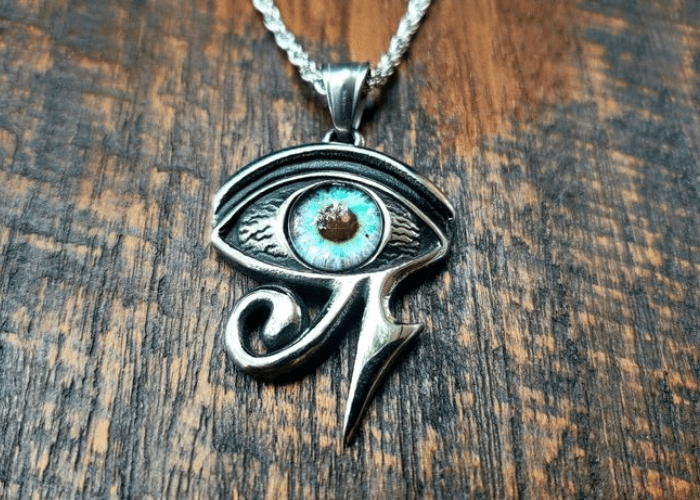
- Necklaces – The Eye of Horus is a popular symbol in necklace design, and can be found in various forms, such as pendants, chokers, and chains.
- Earrings – The Eye of Horus is often used as a decorative element in earring design, and can be found in the form of studs, hoops, and dangly earrings.
- Bracelets – The Eye of Horus is a popular symbol in bracelet design, and can be found in various forms, such as bangle bracelets, charm bracelets, and beaded bracelets.
- Rings – The Eye of Horus is often used as a decorative element in ring design, and can be found in various forms, such as signet rings, statement rings, and stacking rings.
- Clothing – The Eye of Horus can also be found in various forms of clothing, including t-shirts, hoodies, and other casualwear, as well as more formal attire such as dresses and skirts.
Overall, the Eye of Horus continues to be a popular and widely recognized symbol in jewelry and fashion, and its use in these fields reflects its enduring popularity and cultural significance.
Eye of Horus and Eye of Ra Abilities:
In ancient Egyptian mythology, the Eye of Horus and the Eye of Ra were both thought to have powerful abilities. The exact abilities attributed to each eye varied depending on the myth or story being told, but some of the most commonly mentioned abilities include:
Eye of Horus:
- Healing – The Eye of Horus was considered a symbol of healing, and was often invoked to protect against illness and injury.
- Protection – The Eye of Horus was also thought to provide protection, and was worn or carried as a talisman to ward off evil.
- Wisdom – The Eye of Horus was associated with wisdom and knowledge, and was considered a symbol of divine insight.
Eye of Ra:
- Destruction – The Eye of Ra was considered a powerful force of destruction, and was sometimes invoked to bring down the wrath of the gods on enemies.
- Light – The Eye of Ra was also associated with light and the sun, and was considered a powerful source of energy and life.
- Creativity – The Eye of Ra was also associated with creativity and the arts, and was considered a source of inspiration for artists and writers.
Overall, the Eye of Horus and the Eye of Ra were both considered powerful symbols in ancient Egyptian mythology, and each eye had its own unique abilities and associations. These abilities and associations have been passed down through the centuries and continue to influence the cultural significance of these symbols today.
Conclusion:
In conclusion, the Eye of Horus and the Eye of Ra are both powerful symbols from ancient Egyptian mythology that continue to hold cultural significance today. The Eye of Horus was associated with healing, protection, and wisdom, and was considered a symbol of divine insight and knowledge. The Eye of Ra was associated with destruction, light, and creativity, and was considered a powerful force of the sun and a source of inspiration for artists and writers.
While the exact abilities attributed to each eye may have varied depending on the myth or story being told, both symbols were considered powerful and were widely recognized and used in ancient Egyptian society. Today, these symbols continue to be used in jewelry, fashion, and other forms of popular culture, reflecting their enduring cultural significance and relevance.
